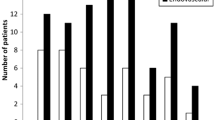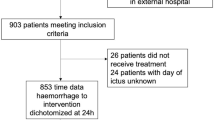Summary
The purpose of the present study was to describe the clinical course of patients with Grade-5 ruptured aneurysms (WFNS grading). Among 250 consecutive cases of ruptured aneurysms, 60 Grade-5 patients were reviewed retrospectively, consisting of 24 males and 36 females with an average age of 58 years. Thirty-two patients were directly transferred to our clinic, while the remaining 28 were referred from other clinics. Duration from rupture to arrival at our clinic was within 1 hour in 25 cases and within 2 hours in 43 cases.
Systolic blood pressure on admission was 186 mmHg on average. Obvious misdiagnoses by primary physicians were made in 7 cases. Ventricular drainage and clipping/trapping of the aneurysms were performed in 7 and 25 cases, respectively. Forty-nine patients died and the remaining 11 survived. One made a good recovery, 1 was moderately disabled, 8 severely disabled, and 1 in a vegetative state.
The prognosis for Grade-5 patients is well known as being extremely poor, which also was the case in our series. Early referral and early surgical intervention have not changed this poor prognosis. Possible improvement of the outcome of this group might be expected by 1) public health and primary physician education on aneurysmal subarachnoid haemorrhage, and 2) control of blood pressure during referral.
Similar content being viewed by others
References
Adams HP, Jergenson DD, Kassell NF, Sahs AL (1980) Pitfalls in the recognition of subarachnoid hemorrhage. JAMA 244: 794–796
Adams HP, Nibbelink DW, Torner JC, Sahs AL (1981) Antifibrinolytic therapy in patients with aneurysmal subarachnoid hemorrhage. A report of the cooperative aneurysm study. Arch Neurol 38: 25–29
Auer LM, Brandt L, Ebeling U, Gilsbach J, Groeger U, Harders A, Ljunggren B, Oppel F, Reulen HJ, Saeveland H (1986) Nimodipine and early aneurysm operation in good condition SAH patients. Acta Neurochir (Wien) 82: 7–13
Fortuny LAI, Prieto-Valiente L (1981) Long-term prognosis in surgically treated intracranial aneurysms. Part 1: Mortality. J Neurosurg 54: 26–34
Gilsbach JM, Harders AG (1989) Morbidity and mortality after early aneurysm surgery — a prospective study with nimodipine prevention. Acta Neurochir (Wien) 96: 1–7
Hijdra A, Gijn JV (1982) Early death from rupture of an intracranial aneurysm. J Neurosurg 57: 765–768
Henderson WG, Torner JC, Nibbelink DW (1977) Intracranial aneurysms and subarachnoid hemorrhage — report on a randomized treatment study. IV-B. Regulated bed rest—statistical evaluation. Stroke 8: 579–589
Kassell NF, Torner JC (1983) Aneurysmal rebleeding: a preliminary report from the cooperative aneurysm study. Neurosurgery 13: 479–481
Kassell NF, Kongable GL, Torner JC, Adams HP, Mazuz H (1985) Delay in referral of patients with ruptured aneurysms to neurosurgical attention. Stroke 16: 587–590
Okawara S (1973) Warning signs prior to rupture of an intracranial aneurysm. J Neurosurg 38: 575–580
Philippon J, Grob R, Dagreou F, Guggiari M, Rivierez M, Viars P (1986) Prevention of vasospasm in subarachnoid haemorrhage. A controlled study with nimodipine. Acta Neurochir (Wien) 82: 110–114
Phillips LH, Whisnant JP, O'Fallon WM, Sundt TM (1980) The unchanged pattern of subarachnoid hemorrhage in a community. Neurology 30: 1034–1040
Richardson AE, Jane JA, Payne PM (1964) Assessment of the natural history of anterior communicating aneurysms. J Neurosurg 21: 266–274
Richardson AE, Jane JA, Yashon D (1966) Prognostic factors in the untreated course of posterior communicating aneurysms. Arch Neurol 14: 172–176
Schievink WI, Werf D, Hageman LM, Dreissen JJ (1988) Referral pattern of patients with aneurysmal subarachnoid hemorrhage. Surg Neurol 29: 367–371
Seiler RW, Grolimund P, Zurbruegg HR (1987) Evaluation of the calcium-antagonist nimodipine for the prevention of vasospasm after aneurysmal subarachnoid haemorrhage. Acta Neurochir (Wien) 85: 7–16
Torner JC, Kassell NF, Wallace RB, Adams HP (1981) Preoperative prognostic factors for rebleeding and survival in aneurysm patients receiving antifibrinolytic therapy: Report of the. Cooperative aneurysm study. Neurosurgery 9: 506–513
Waga S, Ohtsubo K, Handa H (1975) Warning signs in intracranial aneurysms. Surg Neurol 3: 15–20
Weir B, Aronyk K (1981) Management mortality and the timing of surgery for supratentorial aneurysms. J Neurosurg 54: 146–150
Wilkins RH (1980) Attempted prevention or treatment of intracranial arterial spasm: A survey. Neurosurgery 6: 198–210
Author information
Authors and Affiliations
Rights and permissions
About this article
Cite this article
Komiyama, M., Fu, Y., Yagura, H. et al. Fatal aneurysmal rupture: A survey of 60 Grade-5 cases. Acta neurochir 106, 127–131 (1990). https://doi.org/10.1007/BF01809454
Issue Date:
DOI: https://doi.org/10.1007/BF01809454




